Ask real home cinema connoisseurs which subwoofers they would prefer to place and chances are that the answer sounds like “SVS”. That the American brand has such a good reputation among connoisseurs is of course no coincidence. We test the SVS SB-4000, its latest earthquake generator, a sub for people who want to experience bass in their teeth.
The SVS 46-kg SB-4000 we received from importer Cinephil from Namur is nothing less than the superlative compared to the DB2D. This also applies to how the sub is delivered. SVS immediately gets a price for the best packaging from us. We suspect that you can throw this sub from a low-flying cargo plane and that you get it out of the box undamaged.

The SB-4000 comes from the American SVS. Because of its origin and large size you are quick to think that this sub is a stereotypical case of rolling on American muscle balls. Why is it big? Because it’s possible! That kind of thinking that you associate with the Hummer and the triple bacon burger with extra bacon. But let us store those prejudices again, even if only for a moment. Yes, the SB-4000 is compared to typical subwoofers of (mainly) hi-fi manufacturers a real Godzilla. Still, the SB-4000 does not just focus on raw, brute force. This is also a subwoofer with a lot of smart technology on board, including a digital signal processor (DSP) that gives you a lot of extra control. You get something for the 1,999 euros you spend on this SVS SB-4000. That amount seems high, but is not so exorbitant compared to other high-end subs. It is only a few hundred euros more than the Monitor Audio Silver W12 that we have in space as standard, and that is a much more modest thing. The aforementioned DB2D is again just under 3,500 euros. In terms of cubic centimeters you get more at SVS – but that is of course not determined how to judge a subwoofer. In any case, the smart mix of power and technology at a reasonable price is the main reason why this subwoofer recently received an EISA Award as a subwoofer of the year.
SVS SB-4000: Made for home cinemas
About unpacking we do not really have it. Just make sure that there is a second person present who can help you with the drafting, because otherwise you endanger your back and possibly your life. Due to its size of 46.5 x 45 x 53 cm and weight of 46.5 kg this is not a subwoofer for an average living room, but a truly high-end product for real home theaters and ultimate gaming rigs. You also have to put his dimensions somewhere in perspective, because the SB-4000 is a trickle-down version of the even larger SB16-Ultra with its 15.6-inch woofer and 1,500 Watt (real) power. The new device incorporates much of the technology of that spectacular subwoofer, such as the MOSFET Class D amplifier and the Analogue Devices DSP section. The SB-4000 contains a hefty 13.5 inch woofer with a pretty big stroke, big but still more compact than the SB16 Ultra. To steer that enormous driver a double magnet system is provided, which with a weight of 18 kg is responsible for a significant part of the total weight. According to SVS, this driver generates basses from 19 to 310 Hz, ± 3 dB. That is a lower limit where you no longer hear the layer, but feel it.

The model we are looking at is the closed SVS SB-4000, which makes it easier to place due to the absence of ports and also relatively compact remains. There is a larger PB-4000, with three bass ports in the front under the woofer, and the PC-4000, an intriguing and quite beautiful column bass speaker. The three 4000 models are also the successors of the esteemed SB13 subwoofers.
The SB-4000 we received is – outside its size – rather unobtrusively executed in a matt black wood veneer. Neat but not more than that. The sub is also available with a more elegant black piano lacquer, albeit at an additional cost. There are no other colors, but that fits completely into the concept of a subwoofer that gets a place in a darkened home theater. The supplied grille also belongs in a darkened room at home, because it is a heavy metal thing that has to physically protect the woofer. It is not beautiful.
When you take a look at the back of the SVS SB-4000, you immediately see that this subwoofer feels as good at home in consumer surround settings as in more professional installations. Yes, you can simply connect the SB-4000 to your AV receiver via a single LFE cable. But it can also be done via a double cinch cable or via XLR, if available via a high-end output stage. Cinch and XLR outputs allow for easy daisy chaining of additional subwoofers, and a 12 V trigger is not missing either. Two subwoofers may sound absurdly, but there are very good arguments for doing it. With a duo you can neutralize much better room modes (bass frequencies that are amplified by the chamber shape).
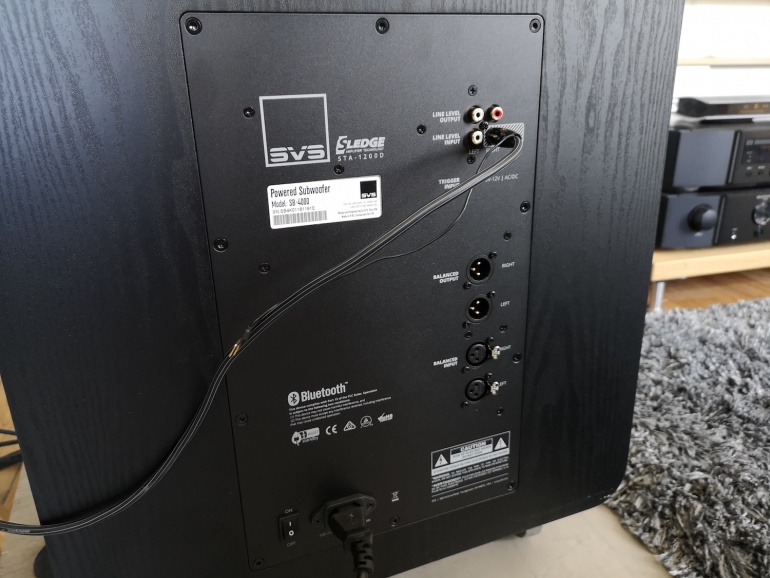
SVS SB-4000: With DSP is better
SVS is certainly not the first to have a DSP placed in a subwoofer. The previously mentioned DB line from Bowers & Wilkins also has all this, just like the ELAC 2070 or the Monitor Audio W12 Silver (our fixed subwoofer in the test room). Yet the American company claims that they go a lot further than other manufacturers, by using a DSP to optimize the amplifier for the woofer, but also to tackle problem frequencies in your room. In contrast to subwoofers such as the DB3D or ELAC 2070, there is no real measurement involved, but you can use the SVS app to manually intervene in various ways on the frequencies produced by the SVS SB-4000. The app (Android and iOS) connects via Bluetooth to the subwoofer, a step that is completed after a few seconds.
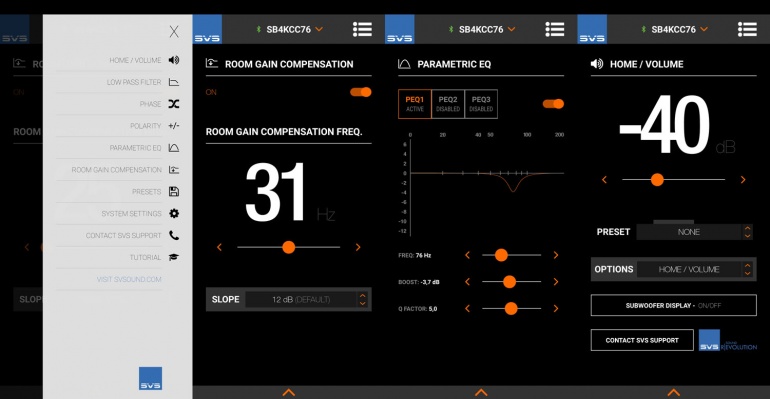
The possibilities of the app are quite extensive for a subwoofer, as you can also read below . But the lack of a room correction system based on a measurement is regrettable, because the required technology is largely in the device. Now you can say that a sub does not need its own correction system, since it may be used in a home cinema with an AV receiver that has the necessary features to solve room problems. That argument is not nonsense, that’s right, but in theory a DSP specifically tuned to a sub should function better than a general algorithm in receiver. But admittedly, it’s a difficult discussion and SVS wants to say that a room correction system like the Bowers & Wilkins, ELAC and Monitor Audio subs mentioned earlier is not really necessary.
That’s different if you want this subwoofer use in a stereo setup with classic stereo amplifiers. Those kind of devices hardly ever have room correction installed, except for rare (expensive) exceptions such as the Micromega M-One and the Anthem STR. Then it is nice that a sub room problems – which are often situated in frequencies below 200-300 Hz – can soften.
SVS SB-4000: A sample sub, but also more
During the test period, the SB-4000 deployed with surround arrangements built around our fixed speaker setup with Dali Rubicon LCR speakers and with a Denon AVR-X6300 (our fixed test receiver) and at another time with a new Onkyo TX-RZ830 about which we will publish a review in the future. Integrating the SVS SB-4000 into your surround setup is not more challenging than with a regular subwoofer. The difference is that via the SVS app you have a level of fine tuning that is usually lacking in others. With the parametric equalizer you can boost or reject a frequency at three points, with an adjustable Q-width. Three bands seem more than sufficient, because you only intervene on a modest frequency range up to approximately 300 Hz. If more corrections are needed, it may be a better idea to first treat the room acoustically. These functions, just like settings such as phase, polarity and low pass filter, may only be used when installing the sub. The same is true for the Room Gain Compensation, where you compensate for a bright or dull space.
However, the app is also useful for daily use, for example if you also consume music with the same system in addition to movies. Via presets you can adapt the behavior of the sub to those different types of audio, or do your own thing via a custom setting. And yes, the volume of the sub is also adjusted via the app (or via the controls on the sub itself). This is more convenient than to dive deep into the AV receiver’s settings if a certain movie has a slightly too high soundtrack. SVS also provides a physical mini-remote that, in combination with the large display on the sub, allows you to control most app functions. The remote is a bit small and fragile.

Let’s say it right away so it’s out of the way: yes, the SVS SB-4000 is a sample sub that can move huge volumes of volumes at higher volumes. You also see him really moving, which is also a form of entertainment. Higher volumes mean no loss of control at SVS, which means that – even if the compensated room mode does not bother you – you will experience detailed, fast bass even in loud volumes. It does not become woolly or unclear, leaving room for the rest of the soundtrack coming from the other speakers. Here our Silver W12 with its smaller woofer does not disappoint, the DB2D would be able to do so thanks to its ingenious double woofer construction. Are you someone who wants to drown the local airport, then you’re undoubtedly good with this SVS subwoofer.
SVS SB-4000: Heavy but also subtle
The ability to play bass quickly and not too much after vibrating is also a huge plus if you like gaming. Shooters often exchange quieter moments with total audio chaos, and that sub must always respond adequately and precisely. Something that the SVS SB-4000 can do perfectly. Very extensively we have not tested the SVS in this scenario, only during a few sessions on the Xbox One X when we went through the Halo: The Master Chief collection in a nostalgic mood.
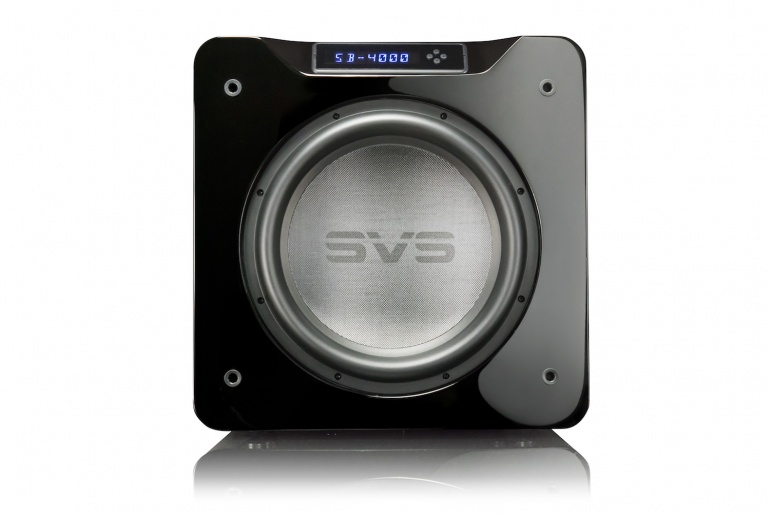
But actually we looked the most when we looked again at test scenes from Thor: Ragnarok, this time at a lower volume. We feared that the SB-4000 would turn out to be too dominant or that at a lower sound level there would not be enough energy to get the woofer to move meaningfully. But again, the SVS SB-4000 was the perfect complement for the rest of the surround setup. The DSP in the SVS subwoofer cleverly knows when to add gas and where to unload it, so that basses are always present in the right proportion. Regardless of the volume, the attack is fast and there is good slam. These features make the SB-4000 unexpected – those prejudices play again! – suitable for supporting a 2-channel setup. The DB2D would get a better score for this application from us, but that is also a more expensive sub that has even more fine control thanks to a dual setup and DSP. This is even more important for music reproduction than with a home cinema soundtrack.
SVS SB-4000: Conclusion
If you even consider the SB-4000, then it might be a good choice for you. The fact that you think about it means that you are already beyond the point of the practical objections. Because there are of course with a device from this class with hope, starting with too expensive and too bulky. These are things that are also at odds with other high-end subs, of course. But if you build a real home theater, that kind of considerations play a little less. Perhaps you will have more space and budget.
The price point of the SVS SB-4000 is very reasonable in the context of your own cinema room, given what you get for it. Because with the SB-4000 you really get a subwoofer that is immensely powerful out of the box and dives very deeply – and that also works smoothly in large spaces. It is also incredibly fast, so that basses are served accurately and compellingly. At the same time, it is also able to subtly support your surround speakers. It is not only suitable for rough work. We never thought to stick this label to this giant, but it is … yes, refined. If it should.
The gigantic icing on the cake is of course the built-in DSP system, which makes the integration of the SB-4000 much easier. You must have the necessary knowledge. We therefore miss an automatic room correction mode – like rivals like the ELAC 2070 and the more expensive Bowers & Wilkins subs -. We only have one advice: watch your back!


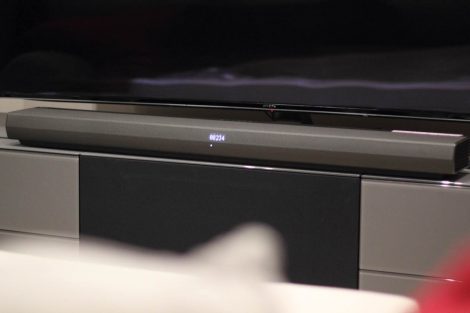
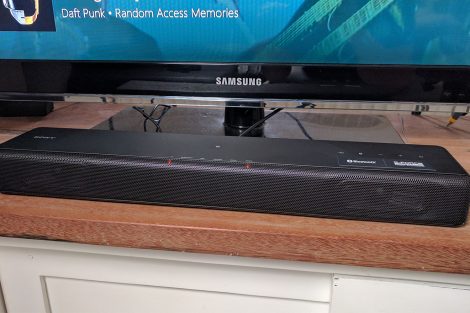
Nice sharing for how to do the install a subwoofer, amplifier and enclosure on the car or vehicle right location to perfect setting. It is a very helpful post for those who want to fix a subwoofer on their rider location.
Here has incredible post for “”. Author share a superb ideas include all think that should be very helpful for everyone. Keeps all about very straightforward. Thanks for posting.
There is no doubt that SVS produces best quality subwoofers in the market with enhanced technology. I own SB-3000 and it works perfectly.
AND the SVS application is the easiest way to unleash the full potential of your 4000 Series, 3000 Series, SVS 16-Ultra, and 2000 Pro Series subwoofers by allowing advanced DSP functionality and optimization based on your room, speakers and personal listening preferences. I like this handy feature because it allows to control music on tips.
Thanks for sharing this review.